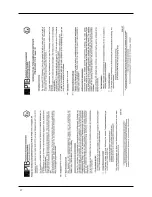
4
ENGLISH
Thermostat connection with explosion
protection
The thermostats are to be connected in such a way that the
motor is switched off via the control circuit when the response
temperature is reached. It must not be possible for the motor
to switch on again automatically after the winding has cooled
down.
WARNING!
After an automatic cut-out via the temperature limiters, the
cause of the malfunction must first be eliminated. Only then
may the motor be switched on again manually.
The restart interlock must be "non-resetting on power failure",
i.e. the lock must be in place to prevent restarting even after a
power cut (in Europe: Directive 2014/34/EU, Appendix II 1.5, EN
60079-17 Table1, B10).
Operation with frequency converter
Frequency converters may only be used for controlling the fre-
quency of special models of three-phase pumps. Alternating
current pumps are unsuitable as a rule.
NOTICE!
For physical reasons, pumps may not be operated at a
higher frequency than that shown on the type plate. If the fre-
quency increases beyond the value on the type plate, the pow-
er input increases and the motor is then overloaded.
For special models of three-phase pumps that are designed for
frequency converter operation, the motor type shown on the
type plate is labelled with an additional "K" (e.g. D90-2/75 CK).
These pumps also have a sticker on the end of the cable that
indicates their suitability for use with a frequency converter.
These special motors are fitted with PTC thermistors as wind
-
ing protectors. Voltages of more than 2.5 V may not be con-
nected to the winding protection terminals 40 and 41! For
explosion protected pumps, a type-tested tripping unit that
complies with the EU type-testing requirements is also neces-
sary.
Rotational direction
Not applicable for alternating current pumps. The rotational
direction must be checked before installation! If the rotational
direction is correct, the start-up jolt should be in the opposite
direction to the rotational direction arrow on the motor hous-
ing. The wrong rotational direction is also indicated if the pump
performs inadequately when installed, or if loud noises can be
heard during operation. If the rotational direction is wrong, 2
phases of the supply cable must be swapped over.
CAUTION!
The start-up jolt can be very forceful.
Potential equalisation
To comply with EN 60079-14 and EN 1127-1, an additional equi-
potential bonding must be installed for facilities with protec-
tive earth conductors in TN/TT networks in areas subject to
explosion hazards. In Germany, for example, the design must
be in accordance with VDE 0100, Part 540 (Association of Ger-
man Electrical Engineers).
No additional potential equalisation is required on site for
JUNG PUMPEN concrete or plastic chambers in explosion
zones 1 and 2 (statement made by TÜV Nord (Technical Inspec-
tion Agency) in March 2008).
Exception: if conductive parts, such as cable protection
sleeves made of corrugated pipe or a pressure pipe made of
metal, are connected to the chamber from the outside. In this
case, an electrically conductive connection must be made be-
tween the conductive parts and the housing of the pump(s).
For corrosion protection reasons, the connection should be
made using stainless steel.
Explosion protected pumps have a special connection point at
the cable entry point.
INSTALLATION
The pump must be installed as shown in the examples. For in-
stallations in accordance with EN 12056-4, the pressure pipe
must be laid in a loop above the local back pressure level and
protected with a back pressure valve.
Example installation
with guide rail system
Assembly:
Fix the coupling base firmly to the floor of the col
-
lection chamber using plugs and then mount the guide rails.
Next, install the pressure pipe including the necessary fittings,
such as the non-return valve and shut-off valves.
Finally, fit the pump with the screwed-on coupling catch on to
the guide rails and lower it into place using a chain fixed to the
shackle.
A fixing facility for lifting gear should be provided above the
chamber opening at a sufficient height.
Level monitoring can be carried out using various systems.
Their specific characteristics and requirements can be found
in the relevant operating manuals.
WARNING!
In accordance with the explosion protection laws and regula-
tions, JUNG Ex-pumps should never be allowed to run dry or to
operate in "snore" mode.
The pump must switch off when the water level sinks to the
upper edge of the pump housing (x in the illustration), at the
very latest. This shut-down must be implemented via a sepa-
rate switching circuit. Dry running for servicing or inspection
purposes may only take place outside the potentially explosive
area.
A correspondingly larger diameter pipe should be used for
longer pressure pipelines to avoid pipe friction losses.
Rising pressure pipes must be protected from frost! A cham-
ber cover must be selected that is suitable for the intended use
and has the required load-bearing capacity.





































